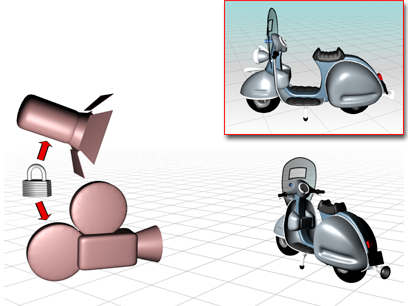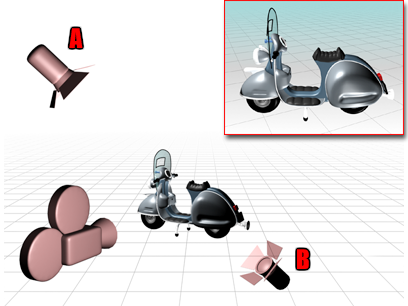
Interface
- View Setting Presets
- Sets the display quality for the viewport: High Quality, Standard, Performance, or DX mode.
- Both the Standard and Performance settings use default lighting. Use DX mode when working with DirectX shader materials.
- Rendering Level
- Sets the rendering level. The options are Basic, Advanced, and DX.
Lighting and Shadows group
Controls how lights are displayed in viewports other than wireframe views.
The default setting and availability of these controls depend on the visual style you have chosen.
- Illuminate
- Sets how to illuminate the scene in the viewport:
-
Default Lights (The default.) Illuminates the viewport using the default lights. If no lights exist in the scene, the default lighting is used automatically, even when Scene Lights is chosen.
Sometimes the lighting you create in the scene can make objects difficult to see in the viewport. The default lighting displays the objects with even illumination. You can use either one or two lights. By default, 3ds Max uses one default light.
- Scene Lights Illuminates the viewport using light objects in the scene. The number of lights is unlimited.
-
Default Lights (The default.) Illuminates the viewport using the default lights. If no lights exist in the scene, the default lighting is used automatically, even when Scene Lights is chosen.
- Default Lights
- Sets the number of default lights, either one or two.
- 1 Light Provides an over-the-shoulder light with 20% faster redraws at the expense of less natural illumination.

A single default light is linked to the camera and moves when you change your viewport point of view.
- 2 Lights (The default.) Provides more natural illumination, but slower viewport performance.

Two default lights are placed opposite to each other.
The key light, A, is in front of the object, on the upper-left side, while the fill light, B, is behind on the lower-right side.
- 1 Light Provides an over-the-shoulder light with 20% faster redraws at the expense of less natural illumination.
- Lighting and Shadows Quality
- Sets the style of lighting used to generate shadows, and the kind of shadows generated. Range: From Point Lights/Hard Shadows to 16.0X - Very High Quality. If the setting is higher than Point Lights/Soft-Edged Shadows, area lights are taken into account. Default = 1.0X - Default.
- Default Lights Follow View Angle
- When enabled, two default lights track changes to the viewport position. (A single default light always tracks the viewport position.)
Your choice depends on the nature of the scene:
- If lights follow the view angle, this provides good character or object lighting with a main head lamp and a rim fill light.
- If lights don't follow the view angle, you get good lighting for interior scene walkthroughs (as in previous versions of 3ds Max).
- Highlights
- When on, viewports include highlights that come from the lighting. Default=on.
- Skylight as Ambient Color
- When enabled, sky lights contribute ambient color to the Realistic viewports, but are not treated as shadow-casting lights.
Fully shadow-casting sky lights are accurate and give good results with outdoor scenes, but can cause problems in interior scenes.This option is not as physically accurate as treating sky lights as fully shadow-casting lights, but It can improve the appearance of interior scenes.
- Auto Display Selected Lights
- When enabled, light from selected lights is automatically displayed in shaded viewports. Default=off.
Some default settings and the availability of these controls depend on the visual style you have chosen.
- Reflections From Environment
- When enabled, glossy materials in Realistic viewports reflect the environment map. This gives good results with outdoor scenes (for example, on a shiny car body), but with high dynamic range (HDR) images, problems can occur in indoor scenes, for example with shiny floors. Turn off this toggle to correct any problems.
- Shadows
- When enabled, the scene is rendered with shadows.
- Shadow Intensity/Fade
- Controls the intensity of shadows. The higher the value, the darker the shadows.
- Ambient Occlusion
- Enables ambient occlusion (AO). AO improves shadow quality by taking into account the proximity of objects. When AO is enabled, the controls for it become available.
- Ambient Occlusion Radius
- Defines the radius, in 3ds Max units, for occluding objects. Larger values cover larger areas.
- Ambient Occlusion Intensity/Fade
- Controls the intensity of the AO effect. The higher the value, the darker the shadows.
Additional Parameters group
- Material Rendering Level
- Sets the level of detail and effects in material rendering. Select either basic smooth shading, advanced high-quality shading, or the current material editor setting.
Note: This option only affects material display in the viewport, not final renders.
- Material Override
- Overrides materials with fast shading or the UV checker image.
- Transparency
- Turns transparency on and off. Objects with transparent materials show as black when this setting is off.
- Apply to All Views
- When enabled, applies the currently selected settings to all visible viewports upon clicking OK.